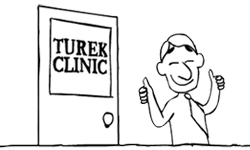I give a Certificate of Honor to specially recognize every patient on whom I perform a vasectomy. It’s really quite nice and very frameable. “Why?” You ask.
Well, it’s not that a no scalpel vasectomy is the most gruesome thing that a man could experience in his life. It’s just that, in the real world of fish stories and Internet tales, it would appear to be the most gr
uesome thing a man can do in his life. And for taking that leap of faith, and believing that it won’t be as bad as they say it is, men in my practice get congratulated in this way.

Pain Down There
The most feared issue surrounding vasectomy? Certainly not the fact that men fire blanks afterwards. Most are just fine with having the gun go off without any resulting collateral damage. It’s the pain thing.
If you read the published literature on vasectomy, you will find that anywhere from 5 to 33% of men experience some form of pain after vasectomy, whether it is acute or chronic, mild or debilitating. I agree that there is the potential for pain when flow in any organ system is blocked, but these numbers seem awfully high.
What’s Going On?
Over the last 20 years, I have treated hundreds of men with scrotal pain in the absence of vasectomy, and have also performed thousands of vasectomies. I have believed every patient who said they had pain and tried my best to diagnose and relieve it. From this experience, here are my thoughts about vasectomy-related pain:
Early Pain
Procedure Pain. Operating on this place is different, trust me, than anywhere else on the body. Remember, it’s the scrotum, where the family jewels live, and not a finger or a toe. An awful patient vasectomy experience can be life changing for men. That’s why I use oral or intravenous sedation liberally, play cool jazz, promote diverting conversation, use two types of local anesthesia and move ever so fast (9 minutes) to ensure a pain-free experience.
Recovery Pain. I have followed hundreds of men online with Healthloop.com for several weeks after vasectomy, so I know every blip and bump in their recovery. They average 2 pain pills afterwards, and I even tell them to take one pill that evening and another the next morning, just to be sure. Along with a few scattered Tylenol or Ibuprofen pills, this is usually it.
Granuloma Pain. About 1-5% of men may contact me anywhere from weeks to months after a vasectomy with the concern: “There is a pea-sized bump down there and it hurts when I touch it.” This is inflammation around the vasectomy site likely due to the exposure of the body to sperm that either leaked out at surgery or afterwards. It is self-limited and resolves soon enough, and may be helped by taking ibuprofen regularly for several days.
Later Pain
Epididymitis. Rarely (<1%) men present with an episode of scrotal pain years after vasectomy. There may even be swelling, but no fever and no granuloma are present. This is classic epididymal “blowout” with sperm leakage due to prolonged backpressure in the system from the vasectomy. It is not infectious and so antibiotics don’t help. Ice, ibuprofen and time help the most. It usually goes away completely and that’s that.
Congestive Pain. Occurring in <1% of patients, this is the classic “post-vasectomy pain,” It typically starts as “discomfort down there,” that becomes more bothersome over time. There is no granuloma, but the epididymis can feel distended on exam. Often associated with a “low” vasectomy (nearer to the testicle and not higher in the scrotum), it is simply distention in the system that occurs as fluid and sperm build up over time behind the vasectomy. The best prevention is to perform a “high” vasectomy and leave lots of “piping” to relieve distention. The best curative treatment is vasectomy reversal to restore normal flow in the system.
Neurogenic Pain. Although very rare (1/250 cases), this is the “sticky wicket” of pain after vasectomy. It may begin with a less than optimal vasectomy experience (try to avoid this!) with pain that doesn’t improve, or even worsens. There is often a lot of anxiety present, but the physical exam is normal. Some urologists think that pinched nerves during vasectomy are the cause, but others do not. In my view, the best prevention is to do the simplest (i.e. “in line”) vasectomy that doesn’t risk damage to surrounding tissues and nerves and also to provide a great, up front, patient experience. I offer multimodality treatment that includes nerve blocks, neuromodulators, pain therapy and anti-inflammatory and have been very successful in ridding men of this condition.
So there you have it. The bare bones, nitty gritty on pain after vasectomy. Will you have pain after your vasectomy? Sure, as you heal you might. But after that, it is important to have common sense about things uncommon.
To read more from Dr. Turek go here



